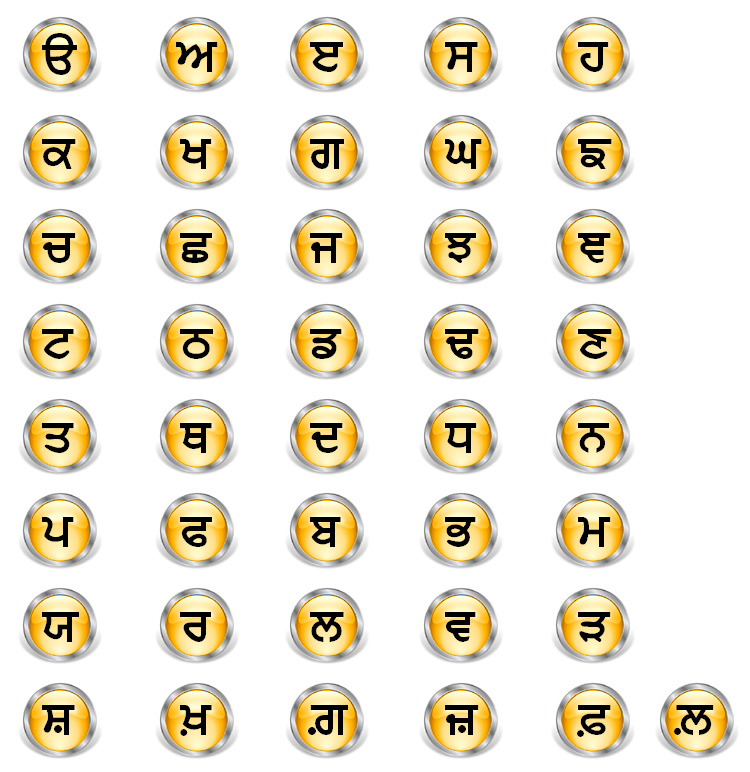Punjabi Alphabet ਗੁਰਮੁਖੀ ਪੈਂਤੀ
The Guru Granth Sahib is written in Gurmukhi, the Sikh prayer language. “Gurmukhi” translates to “of the guru’s mouth.” Guru Angad Dev Ji, the second Sikh guru, strongly emphasised daily text reading. He created a phonetic script that the average person could quickly learn based on a script from the 16th century. Guru Angad transcribed the compositions of his predecessor, Guru Nanak, into Gurmukhi.
Despite having comparable vocabulary to modern Punjabi, the ancient Gurmukhi language is grammatically different since it is a poetic rather than spoken language. Other contemporary characters that are absent from the Gurmukhi script and the scriptural texts of the Guru Granth Sahib are also present in the Punjabi alphabet.

Characters of the Gurmukhi script alphabet, or 35 akhar, are grouped to form a grid. The top row has three vowel holders followed by two consonants. The remaining 32 consonants are arranged so that the second through sixth rows have both horizontal and vertical significance to their pronunciation. For example, the last vertical row of letters all have a nasal inflexion. The fourth horizontal row is all palatal and each is pronounced with the tongue touching the roof of the mouth just behind the ridge in the back of the teeth, while the fourth vertical row is aspirated and pronounced with a puff of air, and so on.

Gurmukhi consonants with a subscript dot are called “pair bindi” meaning a dot at the foot. These do not appear in the sacred scripture of Guru Granth Sahib, but may occur in other written compositions, or dissertations, revered by Sikhs. These are very similar to the parent consonant with slightly aspirated difference in pronunciation, or other subtle inflection of the tongue or throat. Their main importance is that they give different meaning to words which are homonyms, or similar in spelling and sound.

Gurmukhi Vowels
Gurmukhi has ten vowels, or “laga matra” one of which is understood rather than written, and has no symbol. It is known as “mukta,” and means “liberation.” A mukta is pronounced between each and every consonant wherever no other vowel is present unless otherwise indicated. A vowel holder is used where there is no consonant between vowel sounds. The vowel symbols are noted above, below, or to either side of consonants, or their respective vowel holders.

Auxiliary Symbols
Auxiliary Gurmukhi symbols indicate double consonants, or the absence of a vowel, or conjunct adjacent consonants.
Subscript: Conjunct subjoined consonants – Paireen. Where a second adjacent consonant follows the first, with no mukta or other vowel between the two, a miniature subscript symbol indicated at the base of the first represents the second consonant.
Gurmukhi Numerals: Gurmukhi numerals are used to reference verses and page numbers in Gurbani, the hymns of the Guru Granth Sahib, Sikhism’s holy scripture, Nitnem, the required daily prayers, Amrit Kirtan, the Sikh hymnal, and other Sikh prayerbooks. Many references of spiritual significance are made to numbers in Sikh scripture and texts.

Miniature Gurmukhi numbers appear as notations at the foot of certain texts in Guru Granth Sahib, and are indicative of subtleties regarding the raga measure in which they appear.
Gurmukhi Punctuation

Punctuation symbols indicate the separation of heading and text or line break:
-
- Visarg – two circles, one above the other, similar to a colon, indicates the separation of heading from the body of the text or abbreviation of a word in the heading.
-
-
- Dandi – a single vertical line indicates a sentence stop.
-
- Dodandi – a double vertical line indicates acts as a period to indicate a line break in the text.
